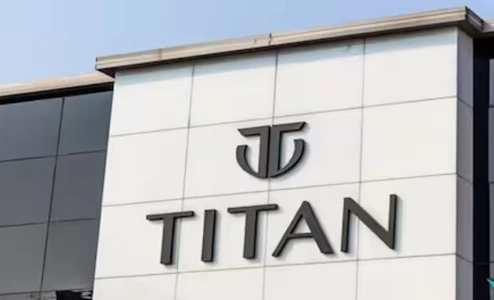Titan Company Limited, a part of the Tata Group, is one of India’s most iconic lifestyle brands. Since its inception in 1984 as a joint venture between the Tata Group and Tamil Nadu Industrial Development Corporation (TIDCO), Titan has grown into a diversified consumer business. It operates across various categories, including watches, jewelry, eyewear, and accessories, with renowned brands like Tanishq, Titan, Fastrack, CaratLane, and Titan Eye+ under its umbrella. Titan has become synonymous with trust, quality, and innovation in India’s lifestyle and fashion industry.
This article delves into Titan’s business model, revenue streams, and strategies that have propelled it to the forefront of India’s consumer products market.
Overview of Titan’s Business Model

Titan operates on a B2C (Business-to-Consumer) model, offering premium, mass-market, and affordable luxury products across multiple lifestyle segments. The company leverages strong brand equity, a vast retail network, and innovative product lines to cater to a wide spectrum of customers.
Key Features of Titan’s Business Model:
- Diverse Product Portfolio:
- Titan offers products across multiple categories, including watches, jewelry, eyewear, fragrances, and accessories.
- Integrated Manufacturing and Retailing:
- The company controls the value chain from manufacturing to retail, ensuring quality and efficiency.
- Omnichannel Presence:
- Titan has a robust physical retail network complemented by a strong online presence through its e-commerce platforms and third-party marketplaces.
- Brand Differentiation:
- Titan segments its brands to target diverse customer groups, from budget-conscious buyers to premium consumers.
- Trust and Innovation:
- Titan emphasizes trust, quality, and design innovation, especially in categories like jewelry and watches.
How Does Titan Earn Money?
Titan generates revenue through multiple product categories and channels, leveraging its diverse offerings and strong retail presence. Here’s how Titan earns money:
a. Jewelry (Tanishq, CaratLane, Zoya)
- Primary Revenue Driver:
- Jewelry is Titan’s largest business segment, contributing over 80% of its revenue.
- Tanishq, the flagship brand, offers gold, diamond, and platinum jewelry, targeting middle- to high-income customers.
- CaratLane (Titan’s online-first jewelry brand) caters to millennials with lightweight and affordable options.
- Zoya, a luxury jewelry brand, focuses on ultra-premium designs and high-net-worth individuals.
- Revenue is generated through:
- Sales of jewelry across physical stores and e-commerce platforms.
- Making charges on custom jewelry designs.
b. Watches and Wearables (Titan, Fastrack, Sonata, Xylys)
- Titan is the market leader in India’s watch segment, offering a wide range of watches under brands like:
- Titan: Premium and mid-range watches.
- Fastrack: Trendy, youth-focused timepieces and accessories.
- Sonata: Affordable watches targeting mass-market consumers.
- Xylys: A luxury Swiss-inspired watch brand.
- The company has also ventured into smartwatches and wearables, earning revenue from tech-driven products like Titan Smart and Fastrack Reflex.
c. Eyewear (Titan Eye+)
- Titan Eye+ contributes to Titan’s revenue by offering:
- Prescription eyewear, sunglasses, and contact lenses.
- In-house brands and collaborations with global eyewear companies.
- Value-added services like eye tests and custom fittings at Titan Eye+ stores.
d. Fragrances and Accessories (Skinn, Fastrack, and Others)
- Titan has entered the lifestyle segment with:
- Skinn by Titan: A premium fragrance brand.
- Bags, belts, and wallets under brands like Fastrack.
- These segments contribute incremental revenue while strengthening Titan’s lifestyle positioning.
e. Retail Network
- Titan earns revenue through its extensive physical retail network, with over 2,000 stores across 350+ cities in India. Key formats include:
- Standalone Stores: Tanishq, Titan World, Fastrack, and Titan Eye+ outlets.
- Shop-in-Shops: Partnerships with large retail chains and malls.
f. E-Commerce
- Titan has built a robust online presence through:
- Dedicated websites for its brands like Tanishq and CaratLane.
- Partnerships with major e-commerce platforms like Amazon, Flipkart, and Nykaa.
- Omnichannel services, such as “Click and Collect” and “Try at Home.”
g. International Markets
- Titan earns revenue from international markets, particularly in the Middle East, the US, and Southeast Asia, by catering to the Indian diaspora and global consumers with products like jewelry and watches.
h. Customization and Corporate Gifting
- Titan provides customization services for jewelry and watches, charging a premium for bespoke designs.
- It also caters to the corporate gifting segment, supplying branded watches, accessories, and trophies to businesses.
i. Investment and Gold Exchange
- Titan offers customers the option to invest in gold through Tanishq’s Gold Exchange and Savings Schemes, which lock in gold rates and encourage long-term purchases.
Why Titan’s Model Works
Titan’s business model has consistently delivered growth and profitability due to its strong brand positioning, operational efficiency, and customer trust. Here’s why its model works:
a. Brand Equity
- Iconic brands like Tanishq, Titan, and Fastrack enjoy high customer loyalty and recognition.
b. Diversified Product Lines
- Titan caters to various income groups and preferences, reducing dependency on any single segment.
c. Trust and Transparency
- Titan’s emphasis on purity in jewelry (e.g., Tanishq’s karat meter) and high-quality products builds trust among customers.
d. Retail and Omnichannel Strategy
- Titan’s expansive retail network and seamless integration with digital platforms ensure reach and convenience.
e. Innovation and Design
- Titan stays ahead of trends by consistently introducing innovative designs and tech-driven products like smartwatches.
f. Cost Efficiency
- Vertical integration and in-house manufacturing of watches and jewelry help Titan optimize costs and maintain competitive pricing.
Financial Performance
Titan’s robust business model is reflected in its financial performance:
Revenue Growth
- Titan reported consolidated revenues of ₹40,000 crores in FY 2023, driven by strong growth in the jewelry and watch segments.
Profit Margins
- Jewelry, with its higher margins and strong sales volumes, remains the most profitable segment for Titan.
Market Leadership
- Titan holds a 50%+ market share in the organized watch segment and is a dominant player in India’s branded jewelry market.
Challenges and Opportunities
Challenges
- Intense Competition:
- Titan faces competition from traditional jewelers, global watch brands, and e-commerce platforms.
- Gold Price Volatility:
- Fluctuations in gold prices impact customer demand and margins.
- High Operating Costs:
- Managing an extensive retail network involves significant overhead costs.
Opportunities
- Rural Expansion:
- Expanding into Tier 2 and Tier 3 cities presents untapped potential.
- Smartwear Growth:
- Increasing demand for smartwatches and wearables is a key growth area.
- Sustainability:
- Introducing eco-friendly products and sustainable practices can attract conscious consumers.
- Global Market:
- Expanding its international footprint can drive revenue growth.
Future Prospects
Titan is poised for continued growth, driven by strong demand for branded jewelry, watches, and lifestyle products. Key focus areas include:
- Scaling its omnichannel capabilities for seamless customer experiences.
- Expanding its product offerings in high-growth categories like smartwatches and fragrances.
- Strengthening its international presence to capture new markets.
- Leveraging technology for personalization and inventory management.
Conclusion
Titan’s business model is a perfect blend of innovation, trust, and customer-centricity. By diversifying its product portfolio, building strong brand equity, and leveraging its retail and digital capabilities, Titan has established itself as a leader in India’s lifestyle and consumer goods market. As the company continues to expand its offerings and embrace new opportunities, Titan is well-positioned for sustained growth and long-term success in both domestic and international markets.

